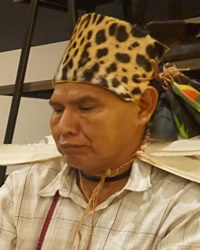Ayoreo in Paraguay

Photo Source:
CIDH - Flickr
Creative Commons
|
Send Joshua Project a map of this people group.
|
| People Name: | Ayoreo |
| Country: | Paraguay |
| 10/40 Window: | No |
| Population: | 2,500 |
| World Population: | 4,800 |
| Primary Language: | Ayoreo |
| Primary Religion: | Christianity |
| Christian Adherents: | 80.00 % |
| Evangelicals: | 20.00 % |
| Scripture: | New Testament |
| Ministry Resources: | Yes |
| Jesus Film: | Yes |
| Audio Recordings: | Yes |
| People Cluster: | South American Indigenous |
| Affinity Bloc: | Latin-Caribbean Americans |
| Progress Level: |
|
Introduction / History
The Ayore are a tribe of the Gran Chaco region in an area between the Paraguay, Pilcomayo and Parapiti rivers that stretches between Bolivia and Paraguay. They were nomadic until the 20th century.
They were first contacted by Jesuit missionaries in 1720. After 20 years the mission was abandoned, and the Ayore were left alone till the early 20th century. The Grand Chaco War between Bolivia and Paraguay brought 100,000 soldiers into the Ayore homeland. Ayore people died in droves, both by diseases and at the hands of soldiers. Paraguayan soldiers were rewarded for killing Ayore people.
Catholic and Protestant missionaries contacted them in the 1940s and 1950s. In 1979 and 1986, New Tribes Mission (New Tribes Mission), helped organize "manhunts" in which large numbers of Totobiegosodeans were forcibly removed from the forest. They were moved to one location and their hunting lands were sold to cattle ranchers. Their land continues to be cleared for ranching, especially in Paraguay. Many Ayore people were forced to move outside their traditional homeland.
What Are Their Lives Like?
The courage and bravery of the Ayoreos occupy a preponderant place. The economy and subsistence of the Ayoreos is based on hunting and gathering, as well as agriculture and fishing. After the contact with the national society, they were induced to develop subsistence farming, the production of handicrafts and to carry out works inside their territory such as: wire fences, preparation of pasture, construction of karanday houses, etc. These last activities were organized by a Salesian mission in the 1970s. Subsequently, the State intervened, orienting the development of the village towards other activities.
What Are Their Beliefs?
They protected their crops from parasites by intoning songs or curses. They painted their bodies with the colors black and red. The black expresses feelings of violence and the second symbolizes eroticism, mainly in young people. They also have a doctor, magician and soothsayer (dahisnai) who uses words, therapeutic songs and mouth blows to perform his cures.
What Are Their Needs?
In addition to unmet medical needs, the Ayore people face a bleak future. There are no easy answers regarding how they can earn a living in the years to come. As it stands, their children have inadequate opportunities to get the education they need to participate in an urban economy.
Prayer Points
Pray for God's guidance and favor in the back-translation of the Bible.
Pray for spiritual understanding and for a clear understanding of the gospel by all.
Pray for economic growth as a testimony of God's goodness and power.
Pray for the Holy Spirit to give them spiritual enlightenment, drawing them to the Lord and away from ancient gods.